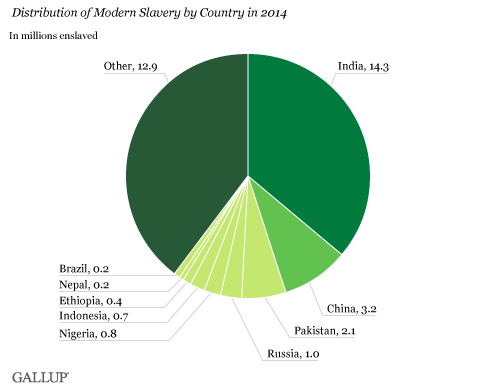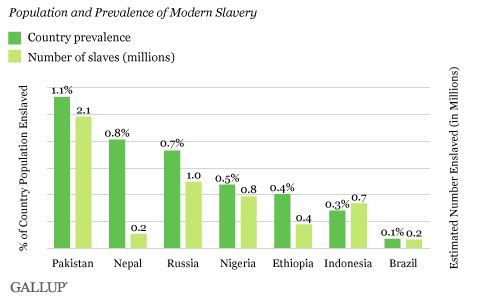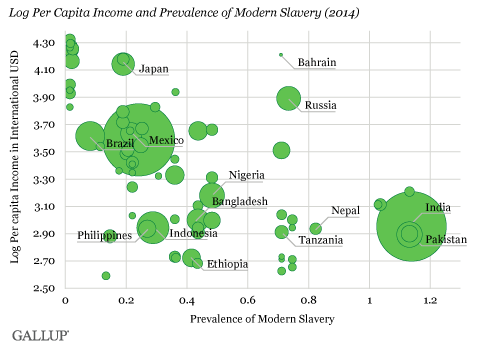Story Highlights
- Latest global estimate finds 35.8 million people enslaved
- Gallup surveys help identify 5.4 million in seven countries
WASHINGTON, D.C. -- Nearly 36 million men, women and children are living in modern slavery worldwide in 2014, according to the second edition of Walk Free's Global Slavery Index (GSI). This estimate includes 5.4 million people in modern slavery identified through Gallup surveys in seven high-risk countries including Brazil, Ethiopia, Indonesia, Nepal, Nigeria, Pakistan and Russia.

The Walk Free Foundation defines modern slavery as the deprivation of individual liberty for the purpose of exploitation. This broad definition includes many slavery-related practices such as human trafficking, forced labor, debt bondage, forced marriage, commercial sexual exploitation and the sale and exploitation of children.
Walk Free's GSI ranks 167 countries according to the estimated prevalence of modern slavery, using a combination of nationally representative surveys, secondary sources and extrapolation methods that take into account each country's vulnerability to modern slavery.
For this second edition of the GSI, Walk Free partnered with Gallup to collect nationally representative survey data in seven countries prioritized because of their high vulnerability and their potential for having a large number of people in modern slavery.

Most modern slavery is not visible to the general public, and victims may not be easy to identify using standard survey methods. Further, even given the large numbers in modern slavery, they only represent a small proportion of any country's population, and so a random sample of individuals may fail to identify any cases.
Gallup used a network sampling methodology to circumvent these problems. Network sampling gathers information about an individual's carefully defined family network, including those who may be living elsewhere. Gallup developed a questionnaire with Walk Free to reliably identify cases of modern slavery among this family network. The questions covered multiple dimensions of modern slavery, including human trafficking, forced labor, debt bondage and forced marriage. Given the sensitivity of the topics, questions were thoroughly field tested, including the use of cognitive interviews with a sample of victims and non-victims in Ethiopia, Indonesia, Nepal, Nigeria, Pakistan and Russia.
Using this approach, Gallup was able to reliably identify men, women and children enslaved in sectors as varied as agriculture, manufacturing or domestic work. Gallup interviews captured a spectrum of experiences, including Ethiopian victims of human trafficking in the Persian Gulf countries. With their passports or wages withheld, these migrant workers found themselves unable to escape their situations. And to get there, many first had to survive a perilous boat trip across the Red Sea, with their lives in the hands of smugglers.
Other cases of modern slavery are more subtle. Nepalese factory workers reported being unable to leave their jobs because of threats of violence or legal action. Pakistani farmers reported being forced to work to repay a debt with their landlord, in fear of repercussions to their families.
Poverty Does Not Explain Everything
Poverty is a clear risk factor behind modern slavery: Poorer countries tend to have more slaves. There is a clear negative relationship between average per capita incomes in 2013, as collected by the Gallup World Poll, and slavery prevalence rates from the 2014 GSI.
But even within countries with similar incomes, there are varying degrees of modern slavery. A country such as Bahrain, where 0.71% of the population is estimated to be in slavery, has a much greater per capita income than a country such as Tanzania, and yet the prevalence of slavery is estimated to be similar. So poverty alone does not tell the whole story. In addition to poverty, a host of other factors may be perpetuating the problem, including traditional institutions, attitudes, social systems or poor governance, as well as individual risk factors such as lack of education or unemployment.

Bottom Line
Obtaining reliable estimates of the extent of the problem of modern slavery is only the first step in eradicating it. Modern slavery will only end after the systematic causes and consequences of the problem are dealt with. First, victims must be identified and get the support they need to leave their situation. Criminal justice mechanisms need to be reinforced and coordinated to successfully prosecute perpetrators. Global supply chains need to be carefully monitored to avoid labor abuses by contractors and subcontractors.
Through its global surveys, Gallup will continue to partner with Walk Free in its mission to give a voice to the millions of people enslaved around the world. For the next edition of the GSI, Gallup will conduct nationally representative surveys in 19 additional countries, including India -- the country with the largest estimate of enslaved people in the world.
Survey Methods
Results are based on face to face interviews with 8,061 adults, aged 15 and older, conducted in May and June 2014 in Brazil, Ethiopia, Indonesia, Nepal, Nigeria, Pakistan and Russia. For results based on the total sample of national adults, the margin of sampling error ranged from ±2.7 percentage points to ±4.0 percentage points at the 95% confidence level. The margin of error reflects the influence of data weighting. In addition to sampling error, question wording and practical difficulties in conducting surveys can introduce error or bias into the findings of public opinion polls.

